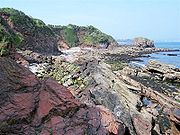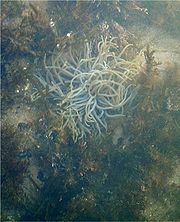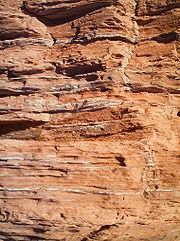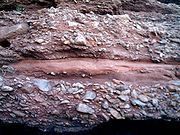
Saltern Cove
Encyclopedia

Site of Special Scientific Interest
A Site of Special Scientific Interest is a conservation designation denoting a protected area in the United Kingdom. SSSIs are the basic building block of site-based nature conservation legislation and most other legal nature/geological conservation designations in Great Britain are based upon...
. It is in Paignton
Paignton
Paignton is a coastal town in Devon in England. Together with Torquay and Brixham it forms the unitary authority of Torbay which was created in 1998. The Torbay area is a holiday destination known as the English Riviera. Paignton's population in the United Kingdom Census of 2001 was 48,251. It has...
, Devon
Devon
Devon is a large county in southwestern England. The county is sometimes referred to as Devonshire, although the term is rarely used inside the county itself as the county has never been officially "shired", it often indicates a traditional or historical context.The county shares borders with...
on the South coast
Coast
A coastline or seashore is the area where land meets the sea or ocean. A precise line that can be called a coastline cannot be determined due to the dynamic nature of tides. The term "coastal zone" can be used instead, which is a spatial zone where interaction of the sea and land processes occurs...
of England
England
England is a country that is part of the United Kingdom. It shares land borders with Scotland to the north and Wales to the west; the Irish Sea is to the north west, the Celtic Sea to the south west, with the North Sea to the east and the English Channel to the south separating it from continental...
.
Flora and fauna

Fucus spiralis
Fucus spiralis is a species of seaweed, a brown alga , living on the littoral shore of the Atlantic coasts of Europe and North America. It has the common names of spiral wrack and flat wrack.-Description:...
) and Knotted wrack
Knotted wrack
Ascophyllum nodosum is a large, common brown alga in the family Fucaceae, being the only species in the genus Ascophyllum. It is seaweed of the northern Atlantic Ocean, also known as rockweed, Norwegian kelp, knotted kelp, knotted wrack or egg wrack...
Ascophyllum nodosum, while pools and crevices in the rocks provide shelter for a wide variety of algal species, such as the red seaweed Corallina officinalis
Corallina officinalis
Corallina officinalis is a calcareous red seaweed which grows in the lower and mid-littoral zones on rocky shores.It is primarily found growing around the rims of tide pools, but can be found in shallow crevices anywhere on the rocky shore that are regularly refreshed with sea water...
. Animals include the Snakelocks anemone
Snakelocks anemone
The snakelocks anemone is a sea anemone found in the eastern Atlantic ocean to the Mediterranean sea.The tentacles of anemones in deep or murky water can be a grey colour but are otherwise usually a deep green colour with purple tips. This is due to the presence of symbiotic algae within the...
Anemonia viridis, the Spotted goby
Spotted goby
The spotted goby, Gobiusculus flavescens, is a small perciform fish found in British coastal waters. Its genus Gobiusculus is monotypic.It is a small, slender goby, reaching up to 6 cm in length...
Gobius ruthensparri, Periwinkles Littorina
Littorina
Littorina is a genus of small sea snails, marine gastropod molluscs in the family Littorinidae, the winkles or periwinkles. These small snails live in the tidal zone of rocky shores.-Overview:...
spp. and the Squat lobster
Squat lobster
Squat lobsters are decapod crustaceans of the families Galatheidae, Chirostylidae and Kiwaidae, including the common genera Galathea and Munida. They are not lobsters at all, but are more closely related to porcelain crabs, hermit crabs and then, more distantly, true crabs...
Galathea strigosa.
At low tide, sandy areas are exposed between the rocks and these support a fauna characteristic of sediment shores including Common starfish
Common starfish
The Common Starfish or Common Sea Star is the most common and familiar starfish in the north-east Atlantic. It has five arms and usually grows to between 10–30 cm across, although larger specimens are known. The Common Starfish is usually orange or brown, and sometimes violet;...
Asterias rubens and burrowing animals such as the Razor shell
Razor shell
The razor shell, Ensis arcuatus, also called razor clam or razor fish, is a bivalve of the family Pharidae. It is found on sandy beaches in Northern Europe and Eastern Canada, such as Prince Edward Island, where it is most populous in the world. It prefers coarser sand than its relatives E. ensis...
Ensis arcuata, the Thin tellin Tellina fabula and the Sea potato
Leathesia difformis
Leathesia difformis, the sea potato, is a littoral brown alga in the class Phaeophyceae and the order Ectocarpales which is commonly attached to other seaweeds and sometimes rocks. When young, the organism is solid but as it matures it become hollow and somewhat convoluted and has the appearance of...
Echinocardium cordatum.
Geology



Devonian
The Devonian is a geologic period and system of the Paleozoic Era spanning from the end of the Silurian Period, about 416.0 ± 2.8 Mya , to the beginning of the Carboniferous Period, about 359.2 ± 2.5 Mya...
sequence, overlain in places by Permian
Permian
The PermianThe term "Permian" was introduced into geology in 1841 by Sir Sir R. I. Murchison, president of the Geological Society of London, who identified typical strata in extensive Russian explorations undertaken with Edouard de Verneuil; Murchison asserted in 1841 that he named his "Permian...
sandstone
Sandstone
Sandstone is a sedimentary rock composed mainly of sand-sized minerals or rock grains.Most sandstone is composed of quartz and/or feldspar because these are the most common minerals in the Earth's crust. Like sand, sandstone may be any colour, but the most common colours are tan, brown, yellow,...
s and breccia
Breccia
Breccia is a rock composed of broken fragments of minerals or rock cemented together by a fine-grained matrix, that can be either similar to or different from the composition of the fragments....
s. The succession is composed of Givetian limestone
Limestone
Limestone is a sedimentary rock composed largely of the minerals calcite and aragonite, which are different crystal forms of calcium carbonate . Many limestones are composed from skeletal fragments of marine organisms such as coral or foraminifera....
s, which are separated by a thrust from a Frasnian
Frasnian
The Frasnian is one of two faunal stages in the Late Devonian epoch. It lasted from 385.3 ± 2.6 million years ago to 374.5 ± 2.6 million years ago. It was preceded by the Givetian stage and followed by the Famennian stage...
– Famennian
Famennian
The Famennian is one of two faunal stages in the Late Devonian epoch. It lasted from 374.5 ± 2.6 million years ago to 359.2 ± 2.5 million years ago. It was preceded by the Frasnian stage and followed by the Tournaisian stage and is named after Famenne, a natural region in southern Belgium.It was...
sequence of slate
Slate
Slate is a fine-grained, foliated, homogeneous metamorphic rock derived from an original shale-type sedimentary rock composed of clay or volcanic ash through low-grade regional metamorphism. The result is a foliated rock in which the foliation may not correspond to the original sedimentary layering...
s and limestones on top of dolerite and tuff
Tuff
Tuff is a type of rock consisting of consolidated volcanic ash ejected from vents during a volcanic eruption. Tuff is sometimes called tufa, particularly when used as construction material, although tufa also refers to a quite different rock. Rock that contains greater than 50% tuff is considered...
s. These beds are adjacent to interbedded thin bands of shale
Shale
Shale is a fine-grained, clastic sedimentary rock composed of mud that is a mix of flakes of clay minerals and tiny fragments of other minerals, especially quartz and calcite. The ratio of clay to other minerals is variable. Shale is characterized by breaks along thin laminae or parallel layering...
s, fine greenish tuffs, red crinoidal limestones, contorted coarse tuffs and red shales and shale limestone. Inshore, an intrusive albite
Albite
Albite is a plagioclase feldspar mineral. It is the sodium endmember of the plagioclase solid solution series. As such it represents a plagioclase with less than 10% anorthite content. The pure albite endmember has the formula NaAlSi3O8. It is a tectosilicate. Its color is usually pure white, hence...
dolerite sill rests on the tuffs.
The next layer up comprises limestones in which fossil
Fossil
Fossils are the preserved remains or traces of animals , plants, and other organisms from the remote past...
s of the coral
Coral
Corals are marine animals in class Anthozoa of phylum Cnidaria typically living in compact colonies of many identical individual "polyps". The group includes the important reef builders that inhabit tropical oceans and secrete calcium carbonate to form a hard skeleton.A coral "head" is a colony of...
s Macgeea, Thamnopora, and Alveolites have been found. A seven meter layer of crinoidal limestone contains the fossil coral Peneckiella salternensis.
At the back of the beach, these rock forms are found again, but here including tuff lenses and pale green reduction bands.
On the northeast side of the point are the Saltern Cove Goniatite
Goniatite
Goniatites are extinct ammonoids, shelled cephalopods related to squid, octopus, and belemnites, that form the order Goniatitida. The Gonatitida originated from within the more primitive anarcestine ammonoids in the Middle Devonian some 390 million years ago...
Band outcrops of the Upper Frasnian age. Limestone clasts above and below this level however, have revealed conodont
Conodont
Conodonts are extinct chordates resembling eels, classified in the class Conodonta. For many years, they were known only from tooth-like microfossils now called conodont elements, found in isolation. Knowledge about soft tissues remains relatively sparse to this day...
s of the quadrantinodosa Zone of the Famennian
Famennian
The Famennian is one of two faunal stages in the Late Devonian epoch. It lasted from 374.5 ± 2.6 million years ago to 359.2 ± 2.5 million years ago. It was preceded by the Frasnian stage and followed by the Tournaisian stage and is named after Famenne, a natural region in southern Belgium.It was...
(Upper Cheiloceras
Cheiloceras
Cheiloceras is a subglobular to thickly lenticular goniatite with a closed umbilicus from the Upper Devonian and type genus for the Cheiloceratidae....
– lower Platyclymenia
Zone) indicating that the Goniatite Bed is an intraformational slump.
Eight metres above the Goniatite Band is a metre-thick limestone conglomerate
Conglomerate (geology)
A conglomerate is a rock consisting of individual clasts within a finer-grained matrix that have become cemented together. Conglomerates are sedimentary rocks consisting of rounded fragments and are thus differentiated from breccias, which consist of angular clasts...
. This displays grading, contains blocks up to 50cm across, as well as small micritic limestone clasts, which contain Frasnian and Famennian conodonts.
Conservation problems
As Saltern Cove lies between the major tourist beaches at GoodringtonGoodrington
Goodrington is a coastal village in Devon, England. It is situated in Torbay and lies between Torquay and Brixham, less than south of Paignton....
and Broadsands
Broadsands
Broadsands is a beach in the Churston Ferrers part of Torbay in South Devon, England.It is a tourist attraction, with a large pitch and putt course. The beach is popular for fishing and watersports....
, there is continual disruption to the site due to rockpooling and collecting. It is believed that the diversity of the site's fauna has decreased by 25% since 1973.

